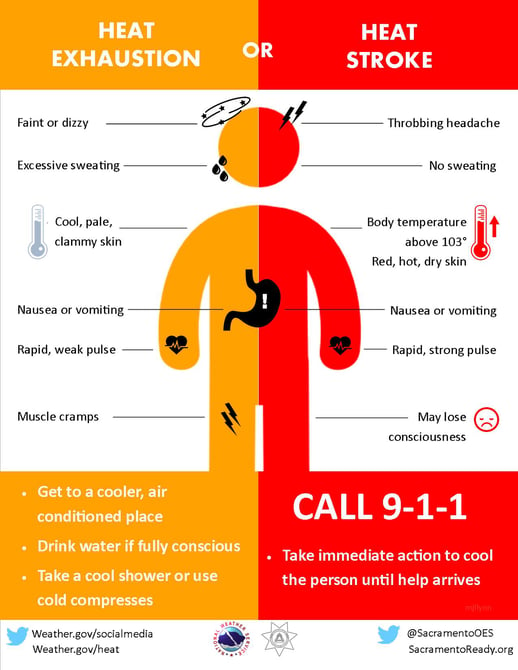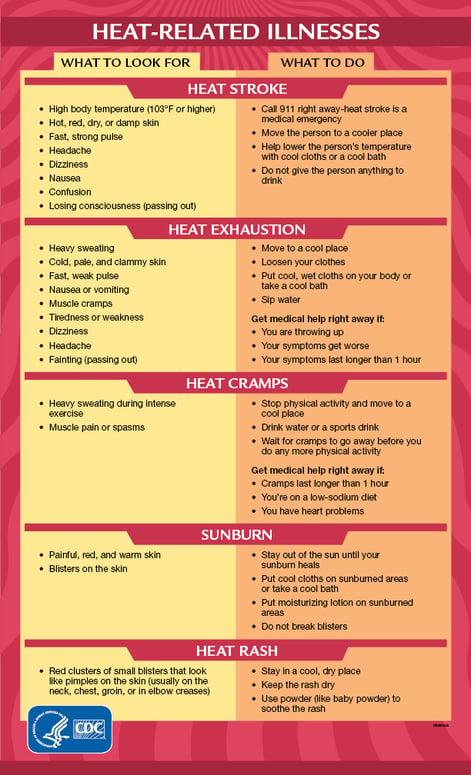2 min read
Emergency Prevention: Heat-related conditions and illnesses
![]() Cecile Garcia, Operations Manager
:
Jun 14, 2019 7:49:44 PM
Cecile Garcia, Operations Manager
:
Jun 14, 2019 7:49:44 PM
Summer officially begins next week (June 21st is the summer solstice this year), which means more time to play in the sun! With an increase in events that make participants sweat and more time in direct heat, the following heat-related conditions and illnesses may arise. Make sure to take precautions, learn to recognize the signs and symptoms, and call 911 when necessary.
Heat Exhaustion
Heat exhaustion results from the body overheating. It may start off as muscle cramps but will progress to other symptoms, such as headache, nausea, vomiting, dizziness and passing out. The person will exhibit excessive sweating, cool skin, and a weak, rapid pulse.
Move them to a cooler environment and help them rehydrate with water or a sports drink. If symptoms progress, call 911.
Heat Stroke
Heat exhaustion can elevate to heat stroke if left untreated. When the body cannot regulate its temperature, heat stroke occurs. Like heat exhaustion, heat stroke may result in headache, nausea, vomiting, dizziness and passing out. However, someone with heat stroke will stop sweating and their skin will be hot to the touch. Their pulse will be rapid and strong.
Immediately move them to a cooler area and cover their body with cooling compresses. You can also dip them in water or soak their clothes in water but make sure to avoid the person’s head. Heat stroke can be fatal. Call 911.
Check out this infographic (available in Spanish as well!) from the National Weather Service to assess whether someone is having a heat stroke or suffering from heat exhaustion.
 Rhabdomyolysis
Rhabdomyolysis
Rhabdomyolysis occurs in extreme heat or due to extreme exercise. It is a breakdown of the muscle tissue. Commonly called “rhabdo”, it happens when the damaged tissue releases muscle components into the bloodstream. These components (such as proteins and electrolytes) can travel throughout the body, resulting in kidney failure, seizures, or heart issues. While rhabdo may display as severe muscle pain and weakness, it can also be asymptomatic. In this case, the first sign may be discolored urine (usually presenting as a dark, tea-like color).
Rhabdomyolysis may occur as a result of other conditions as well, including infections, a metabolic disorder, seizures or certain drugs or medications. Always call 911 when rhabdomyolysis presents itself. It can be fatal.
Sunburn
Sunburn is easy to prevent. Wear sunscreen that has at least an SPF of 15 and broad spectrum protection. Remember to apply sunscreen before stepping out into the sun. Wear clothing that protects your skin from the sun; big floppy hats, long sleeves, and tightly woven fabric help. Seek shade and avoid the sun during peak hours.
When treating a sunburn, use lotions (especially ones with aloe) and cold compresses. If a burn manifests in blisters, do not pop them.
Heat Rash
Most commonly seen in small children, heat rash occurs when sweat cannot move through blocked sweat ducts. A rash appears on the skin, which can be treated with powder.
Keep the rash dry while it heals.
Heat Syncope
Syncope is more commonly known as fainting. When the brain does not receive enough blood, light-headedness and fainting may occur. Standing for long periods of time in heat, not acclimatizing to a hot environment before performing exercise, and moving quickly between a sitting or prone position to standing can cause heat syncope.
Move a person suffering from heat syncope into a seated or prone position in a cooler environment. Elevate their legs and help them rehydrate.
Heat Cramps
Heat cramps are essentially muscle cramps that mainly occur in the limbs due to fatigue and dehydration. Dehydration results in lack of sodium, which causes the muscles to spasm. Like heat syncope prevention, preventing heat cramps also starts with acclimatizing to a hot environment before exercising.
Again, move the person into a cooler environment. Help them rehydrate with water or a sports drink. If possible, massage the muscles, provide a sodium-enriched snack, and, if necessary, apply cool compresses to the affected areas.
Keeping Up with Heat-Related Illnesses
The Centers for Disease Control and Prevention created a handy chart you can print and reference on treatment of heat-related illnesses.
 Remember heat-related illnesses are easy to prevent. They affect young children, the elderly, those on certain medications, and those with obesity the most easily. However, a sudden change in temperature or a high heat index can cause heat-related illnesses in healthy adults as well.
Remember heat-related illnesses are easy to prevent. They affect young children, the elderly, those on certain medications, and those with obesity the most easily. However, a sudden change in temperature or a high heat index can cause heat-related illnesses in healthy adults as well.

